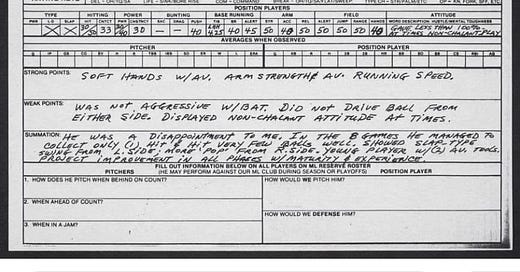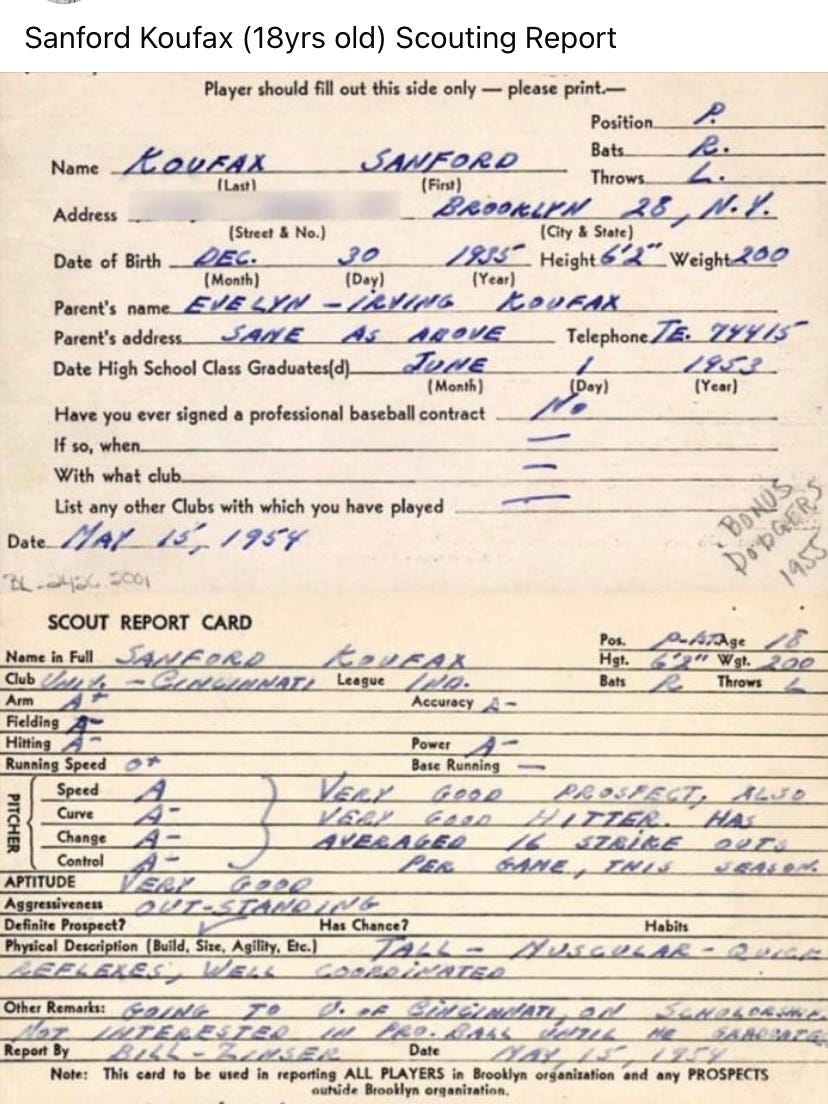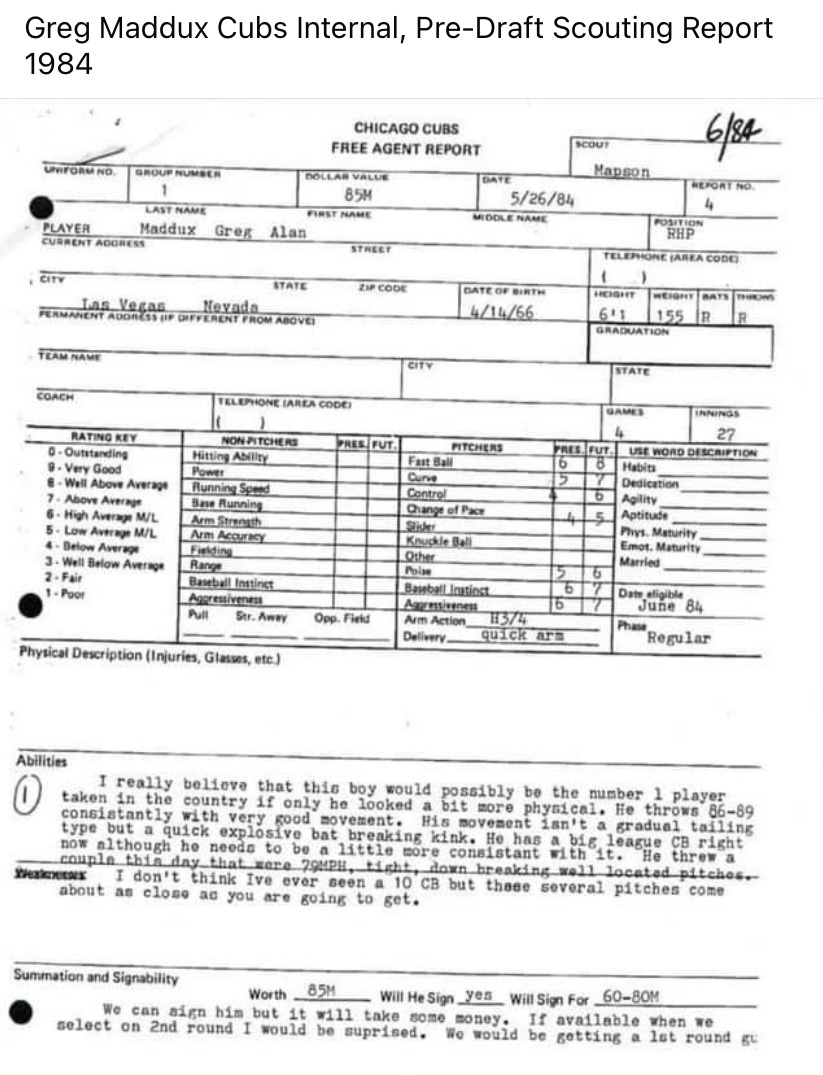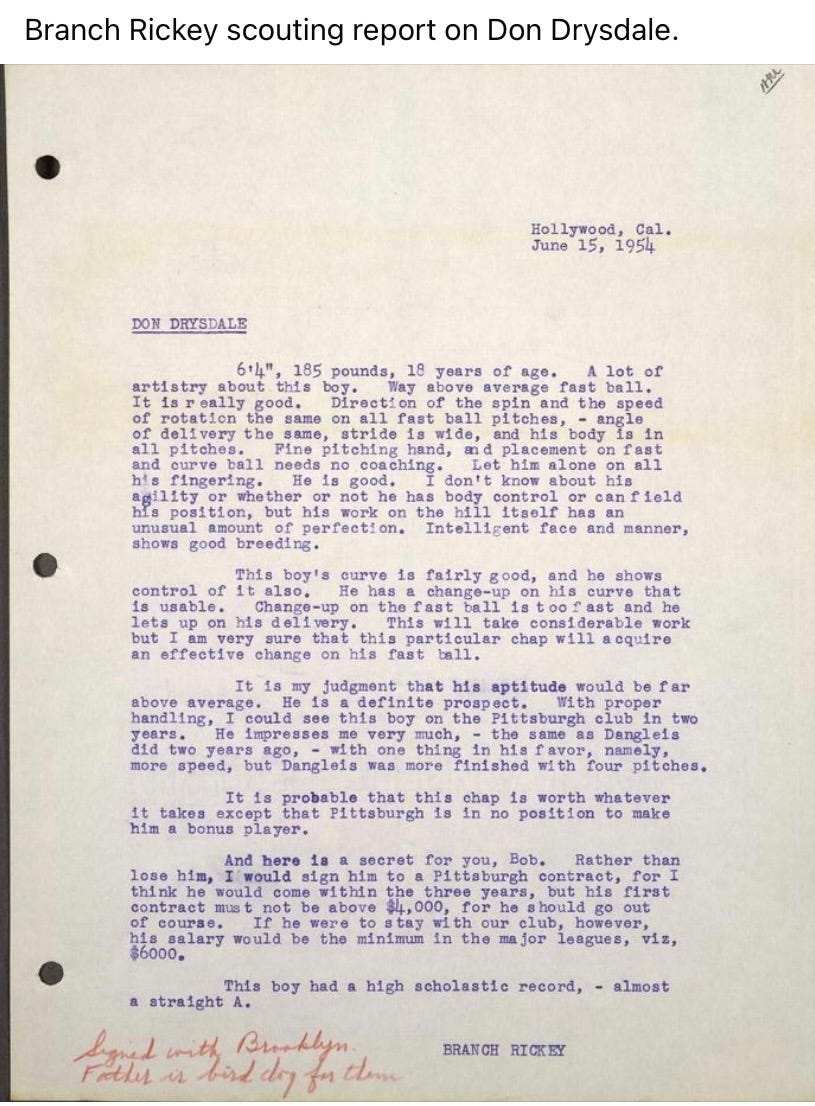You’d find one of the undiscovered gems at Atlanta’s old Turner Field down underneath the stands. There was a wall where were displayed scouting reports of some of the Braves’ players when they were high schoolers. They looked at Hall Of Fame third baseman Chipper Jones as a pitcher. The one on Hall of Fame pitcher Tom Glavine noted his athleticism but not a lot else, as I recall. It was to see if those scouts could see what lay ahead. Sometimes they can, sometimes not.
As you’ll see from the collection of scouting reports (and a letter) here, one was on the money, the letter, from the esteemed Branch Rickey was dead-on target, one could not have been more off and one was full of excitement but not particularly judicious.
Let’s take a look, shall we? First, the swing and miss on HOF Chipper Jones
Having watched a lot of Chipper Jones play baseball, it’s hard for me to imagine him going through any stretch of eight games where he collected only one hit. The scout said Chipper had a “slap-type swing from L. side.” Well, Chipper hit 361 of his 468 lifetime home runs from the left side. “He was a disappointment to me.” Remember that Chipper ended up being the No. 1 overall choice in the draft and also, the only No. 1 choice who made the Hall of Fame. “Was not aggressive w/bat. Displayed nonchalant attitude at times.” This scout’s report is definitely a swing and miss.
What did scouts see in Sandy Koufax at 18?
Well, they saw the speed, all right, giving him an “A+” arm and a surprising “A-” in accuracy, since it would be many years, MANY years before Koufax developed into one of the greatest pitchers in the history of the game. And the reason why it took so long was control. He couldn’t throw strikes. He could, in the old phrase, “throw the ball through a car wash and not get it wet” — IF he could hit the car wash. The other element that, if Koufax himself got to look at was “Very good hitter.” In a 12-year MLB career, Sandy batted .097 with 386 strikeouts in 776 at bats.
What did the scouts see in Greg Maddux?
This guy was on the money. He noted the great movement of Maddux’s pitches, didn’t go nuts that he didn’t throw 90+, was prophetic in that he said “his movement isn’t a gradual tailing type but a quick, explosive bat-breaking kink.” Which was, of course, exactly how Maddux became a Hall of Fame pitcher. “Has a big league CB (curveball) right now.” Give this guy a raise!
What did the great Branch Rickey see in prospect Don Drysdale?
At this point of Branch Rickey’s career, he’d moved on from General Manager of the St. Louis Cardinals (1919-1942) and the Brooklyn Dodgers (1943-1950) and was with the Pittsburgh Pirates (1950-1955). He’d already brought Jackie Robinson into baseball, had developed a minor-league player development system and transformed baseball in a lot of ways. One of my favorite stories was about Duke Snider when he was coming up with the Dodgers. Snider was too swing happy for Rickey’s tastes and despite constant correction from his coaches, he kept on swinging at everything that moved.
So one Spring Training day — Rickey used strings to frame the strike zone for his pitchers — he had Snider get all dressed as if he were going to play and had him stand in the batters’ box for an entire day and forbid him to swing even once. “Call balls and strikes,” were his instructions. For the whole damn day.
You can see in his letter Rickey’s shrewd eye for talent, his sense of what Drysdale could do, his great potential. As we know, the Pirates didn’t get him, the Dodgers did and he was a pretty good counterpart to Sandy Koufax on those great Dodger teams of the 1960’s’.
Having known a few scouts over the years, some of them are very friendly like the great Les Parker, who was a scout for the New York Mets for the longest time. I met Les in the oddest of places — the men’s room. John, then an 8th grader, was starting in left field for the North Florida Christian Eagles in the FHSAA Championship game. We sort of ran into each other on the way in and I could see he had all the trappings of being a baseball scout. We chatted for a moment and I asked him who he was there to see?
This was, of course, privileged information. But Les was so kind, he just laughed. “Oh, I’m looking at a couple of the pitchers,” he said, “and there’s an outfielder I’ve watched. And there’s this eighth grader I’m supposed to check out, too.”
“That’s my son!”
Once the game started, John, batting 9th, drove in the Eagles’ first run, then made a nice running catch to lead off the 9th and NFC went on to win the state title.
Les kept tabs on John’s career from that point on and told me that if it wasn’t for COVID, he’d have been there in Chicago to see John’s MLB debut. “You never know where baseball is going to take you,” he told me once. “Enjoy the ride.”
It was great advice.








Was Branch Rickey the last baseball executive to use the word "chap" unironically? I bet yes. Also amazing to see the historic extent of Pittsburgh's payroll challenges. Great idea for a post!
Great read!